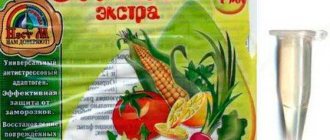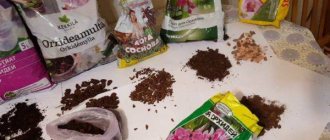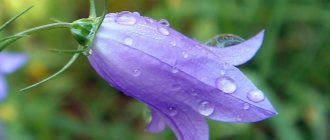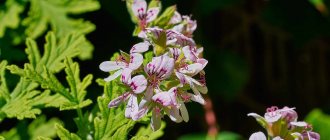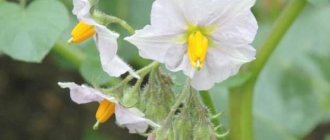Agricola is called the favorite drink of orchids. This is an effective means for feeding house plants, stimulating growth and development, increasing resistance to diseases and stress. The drug is easy to use and is harmless to humans.
However, this is a chemical composition, and orchids are sensitive to excess and deficiency of elements , excess of mineral salts. Therefore, errors in the use of the drug, at best, will not give the desired result, and at worst, will lead to loss of flowering, chemical burns, and plant death. Let's figure out how to properly use Agricola fertilizer.
Description and composition
Agricola is a balanced organic-mineral complex fertilizer , concentrate, produced by domestic producers.
Liquid fertilizer, dark in color, quickly soluble in water, odorless. It poses no danger to humans.
In addition to the main triad of macroelements (potassium, phosphorus, nitrogen), the preparation includes microelements in chelated form :
- boron;
- zinc;
- copper;
- iron;
- molybdenum;
- manganese.
Of particular value are organic humic acids and vitamin supplements - natural biologically active energy sources. By the way, they are the ones who give the fertilizer its earthy tint.
Interesting! Thanks to the presence of these components, Agricola is both a fertilizer and a biostimulant.
The proportional content of potassium, nitrogen and phosphorus is designed to maximally strengthen the orchid’s immunity and stimulate lush flowering. The proportion of nitrogen is lower than in other similar compositions , because the value of an orchid is in luxurious flowering, and not in lush greenery.
Pokon
POKON fertilizer for orchids, 250 ml
The very name of the products indicates that these fertilizers contain a full range of basic plant nutrients:
- phosphorus oxide P2O5 is encrypted in the name in the first syllable - “PO”;
- potassium oxide K2O – in the second syllable – “KO”;
- molecular nitrogen N – in the final letter “N”.
Nutrient Content:
- nitrogen (N) – 5%;
- phosphoric acid (P2O5) – 6%;
- potassium oxide (K2O) – 7%.
The NPK ratio 5:6:7 is most optimal for long-term flowering of orchids.
In addition to the main elements, the fertilizer contains a whole range of microelements that orchids need for long-term flowering:
- boron (B) – 0.02%;
- copper (Cu) – 0.004%;
- iron (Fe) – 0.04%;
- manganese (Mn) – 0.02%;
- molybdenum (Mo) – 0.002%;
- zinc (Zn) – 0.004%.
Advantages:
- Contains phosphorus in a highly soluble form.
- Quickly absorbed.
- A full range of macro- and microelements necessary for orchids.
Forms of release of the drug
Agricola for orchids is available in the form of a gel concentrate and in granular form. The liquid mixes easily with water; it is convenient to measure the required amount using a graduated glass that comes with the container with the drug.
A bag of powdered water-soluble fertilizer can be purchased on the way to the dacha; it is compact and will not take up much space in your purse or pocket.
Agricola release forms.
FERTIKA Kristalon
Kristalon fertilizer for orchids 0.5l, Fertika
“Crystalon for orchids” is produced by Fertika in two versions – in ampoules and in bottles.
They contain the same set of elements, but in different concentrations.
Composition of “Crystalon for orchids” in ampoules :
- Nitrogen 1.7%;
- Phosphorus 1.9%;
- Potassium 2%.
- Magnesium 0.25%
- Sulfur 0.2%
- Boron 0.0025%
- Copper 0.001%
- Iron 0.005%
- Manganese 0.005%
- Molybdenum 0.0005%
- Zinc 0.0025%
Composition of “Crystalon for orchids” in a bottle :
- Nitrogen 3.4%;
- Phosphorus 3.8%;
- Potassium 4%;
- Magnesium 0.5%
- Sulfur 0.4%
- Boron 0.005%
- Copper 0.002%
- Iron 0.01%
- Manganese 0.01%
- Molybdenum 0.001%
- Zinc 0.005%
The peculiarity and main advantage of Kristalon fertilizers is that the minerals in their composition are in the form of chelates.
Chelates are complex compounds of organic and mineral molecules. Chelated complexes are completely bioavailable and are instantly absorbed by plants.
The different concentrations of mineral components in the two versions of “Kristalon for orchids” allow you to adjust feeding taking into account the condition of the plants:
- “Kristalon” in ampoules is suitable for plants that have awakened on their own, are actively growing and are ready to release a peduncle.
- “Kristalon” in a bottle is suitable for orchids that linger in the dormant phase for a long time and are reluctant to bloom.
Properties and effects
The verified, balanced composition of Agricola determined the properties of the fertilizer :
- mobilization of the body's immune mechanisms;
- increasing resistance to diseases of various origins, damage by fungi and bacteria, resistance to pests;
- reducing the waiting time for flowering, increasing its duration, intensity and effectiveness;
- increasing adaptability to unfavorable and changing external factors, stress resistance;
- stimulation of metabolic intracellular processes, which increases the vitality of the plant.
How to use?
The recommended procedure for using Agricola is indicated on the package. Before use, you must carefully study these instructions and follow them strictly.
To prepare a working solution from a liquid concentrate, take the drug at the rate of 5 ml per liter of water for root feeding, and half as much for foliar feeding.
Granular dry composition (25 grams per pack) is diluted in a bucket of water.
This pack is enough for a bucket of water.
Attention! Experts recommend further reducing the concentration of the drug in the following cases:
- feeding a young orchid;
- nutrition of a newly acquired plant in order to study and take into account its individual needs and characteristics.
Standard precautions:
- Prepare the solution while wearing gloves;
- do not allow the solution to come into contact with mucous membranes;
- Upon completion of work, wash your hands and face with warm water and soap.
What is it used for?
There are many types of Agricola. And, accordingly, their purposes are slightly different. For orchids, there is a version of Agricola for indoor orchids.
Its main task is to feed the root system of many species of this plant. But besides the main task, there are also side tasks, such as:
- Feed the plant two weeks after purchase.
- Use of the drug to safely exit the dormant state.
- In case of poor development and drying out, the plant is sprayed with Agricola Aqua solution.
When and what is it used for?
Agricola is a universal complex remedy. It is used in various situations:
- To better adapt the orchid to its new home conditions, but not earlier than a couple of weeks after purchase. Agricola reduces the impact of stress on the plant, shortens the period of adaptation;
- During the growing season , fertilizer stimulates energy processes, brings the start of flowering closer, increases its intensity and duration. The color of the flowers becomes noticeably richer and brighter;
- Agricola is an excellent remedy if the plant withers and develops poorly. The drug improves resistance to disease and triggers restoration processes in the orchid’s body. A distinctive feature of Agricola is the presence in its composition of humic acids - natural energy sources;
- immediately after transplanting an orchid; it is better to wait a few days. Fertilizing should begin after 1.5-2 weeks , then the fertilizer stimulates metabolic processes and the digestibility of nutrients, including water, air, light, and will contribute to the active growth of roots and leaves.
Possible consequences of incorrect processing
Incorrect processing is processing in which the conditions and procedure for use or dosage of the drug are not met. The consequences of such use can be minimal, but, most often, catastrophic, including the death of the orchid. Again, the effects depend on the purpose of use and the dosage of Agricol.
The minimum is yellowing of the leaves, the maximum is death. It is possible and necessary to fight these consequences; one must not give up. The smaller the consequences, the easier it is to fight. But if the plant has already been processed incorrectly and the consequences are catastrophic, then there is little that will help the orchid.
- The first thing to do is to stop using the medications immediately.
- Water and wash the plant periodically.
- Monitor the condition of the orchid.
In general, these rules are the same for most situations, but you need to understand that each case is individual.
Rules of application for feeding
Agricola is intended for root and foliar feeding . To avoid mistakes and achieve the best effect, you must follow the recommendations for using the product.
Root
Fertilizer is applied during periods of active growing season , most often from late winter to mid-autumn. In winter, additional food is delivered to orchids once a month, during active months - every 7-10 days.
For root feeding, take five milliliters of concentrate per liter of water . The substrate and roots are pre-moistened with clean water, then watered with Agricola solution.
Agricola can be used for root feeding.
Foliar
For foliar feeding, prepare a less concentrated solution : take 5 ml per not one, but two liters of water. Processing can be carried out in the following ways:
- spray the plant with a spray bottle;
- wipe the leaves on both sides and aerial roots with a cotton swab dipped in Agricola solution.
Fertilizers delivered directly to the leaves are absorbed five times better. But this method should not be abused; foliar feeding is carried out no more often than once every two to three weeks.
Advice! If you are forced to apply foliar fertilizers while the orchid is blooming, make sure that the fertilizer does not get on the flowers.
Is it useful to feed with ash?
Wood ash is a source of phosphorus, potassium, and calcium. Does not contain nitrogen. Fertilizing is acceptable, but requires taking into account the acidity of the substrate, since the material shifts the pH level towards strong alkalization.
Methods of feeding with ash infusion:
- root (100 ml/1l) – used on substrates pH 4.5-5.5;
- foliar (10 ml/1 l) - for one-time spraying with a carefully strained solution;
- introduction into dry soil is unacceptable.
Precautionary measures
Orchids react very sensitively to chemical components contained in water, air, and fertilizing. Therefore, you should pay close attention to each element of care.
Water requirements
Tap or spring water may contain chemical compounds that are not beneficial for orchids, such as chlorine or zinc.
The best water is considered to be rainwater, melt water, and distilled water. Chlorinated water can be used, but it must first be left in an open container for at least a day.
Overdose: risks, consequences, methods of leveling
Overdose can occur due to:
- one-time use of a solution with an excess amount of Agricola;
- accumulation of fertilizer in the substrate and on the roots for a long time.
Overdose can lead to:
- to burns and death of roots;
- to a sharp reduction in the number of flowers or a complete refusal to bloom, in difficult cases - for several years;
- to growth retardation, developmental disorders;
- to excessive growth of green mass;
- to the growth of twisted, deformed leaves;
- to thickening, and then to cracking of the pseudobulbs.
Excess fertilizer can cause leaf deformation.
To reduce risks, it is recommended to take non-chlorinated water, preferably melt or rain water. In addition, it is more correct to use a slightly lower concentration of the feeding solution than indicated on the package , for example, not 5, but 2.5-3 ml per liter.
If an overdose does occur, the orchid should be removed from the pot, the roots should be washed with clean warm water, and the plant should be placed in a fresh substrate. Cancel any feeding for several months.
Flower paradise for orchids
Fertilizer Buisky chemical plant Flower paradise for orchids, 0.2 l
Ingredients:
- N (g/l): 18.72;
- P2O5 (g/l): 7.2;
- K2O (g/l): 36
- MgO (g/l): 2.88
Microelements: mg/l,
- Fe (DTPA) – 77.76;
- Mn (EDTA) – 60.48;
- Zn (EDTA) – 20.16;
- Cu (EDTA) – 14.4;
- Mo – 5.76;
- B – 28.8
Purpose: fertilizer for root and foliar feeding of orchids.
A balanced complex of highly effective microelements that are easily accessible to plants - Fe, Mn, Zn, Cu, in the form of complex organic salts - chelates, as well as B, Mo.
Advantages:
- Promotes healthy growth and development of plants.
- Stimulates the development of shoots and lush green foliage.
- Eliminates visible manifestations of nutritional deficiency.
- Prevents the development of diseases caused by a lack of certain microelements.
Fertilizer reviews
Flower growers are surprisingly unanimous in their assessment of Agricola.
Andrey. “I feed my orchids only with Agricola. They bloom uncontrollably for 6-7 months. There are 2-4 flower stalks on each, all strewn with large bright flowers. Excellent fertilizer! It is convenient to measure, there is a special measuring cup. And on the bottle there is a recess for it, it’s convenient to store and won’t get lost. It is not advisable to water Agricola only during flowering: for some reason, my flowering time is reduced to 3 months. Therefore, I feed before the first flowers appear and after flowering.”
Marina. “Good fertilizer, high quality. But nothing outstanding. Just a good, reliable feed, but not a growth stimulant.”
Anna. “Agricola was a real lifesaver for my orchids in the first year! These were my first orchids, and I learned everything. Agricola was recommended. As I got “bored” and the plant got sick, I started spraying it. After two or three months, the orchid is healthy and throws out its flower stalks. Very pleased! Easy to use - follow the instructions. To avoid mistakes with the dosage, there is a glass with markings. The bottle is 250 ml, lasts a long time, the price is more than affordable.”
Natalia. “One orchid did not bloom for almost 3 years, for no apparent reason. Healthy leaves, strong succulent roots, and not blooming. A friend recommended trying Agricola. The substrate was watered and the leaves were sprayed for 2 or 3 months. Our beauty has bloomed! Thank you Agricola!”
Fertilizers for orchids (video)
The method of foliar feeding is used at the stage of active plant growth, as well as in the presence of signs of chlorosis, which is a lack of microelements. In addition, such fertilizing is used in case of damage to the root system. Foliar feeding should be done in the morning or in cloudy weather so that direct sunlight does not fall on the leaves of the plant. Thorough spraying ensures that the drug reaches the aerial roots and leaves on both sides. Flower buds and the flowers themselves should be protected from the solution. Otherwise, rotting and death of growth points may occur. Immediately after fertilizing, the plant should be carefully inspected and dried.
Is it possible to feed a blooming orchid with Agricola?
It has been noticed that the use of fertilizer at this time significantly reduces the lifespan of peduncles ; buds and flowers dry out and fall off.
Using Agricola during flowering may cause flowers and buds to fall off.
In cases where treatment cannot be avoided “for health reasons”, you should avoid getting the solution on flowers and buds and limit yourself to the minimum required amount of the drug.
Important! With the appearance of buds and throughout the flowering period, fertilizing should be discontinued.
Tips and tricks
The method of root feeding is intended to qualitatively replenish the supply of macroelements and microelements of healthy orchids. Before feeding, you should thoroughly moisten the root system of the flower. The fertilizer should be diluted in warm and clean tap water until a solution is obtained in the concentration indicated on the product label. It is necessary to slowly immerse the flower pot with the plant in a container with clean water, watering it with the resulting fertilizer solution from above. Leave the plant in this position for 20 minutes. The excess volume of solution is removed through flow into the pan.


